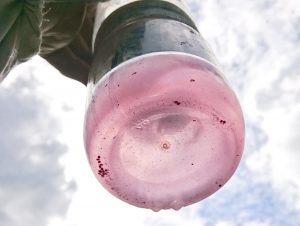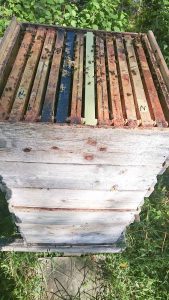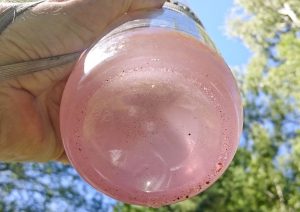Last year I saw more wingless bees than I had expected and I used more thymol than I had expected. I realized that I could partially thank the bad weather fort thias. The bees had got too little of pollen. Their immune system was not at its peak.
It was not easy to find suitable breeder queens, ie, who showed great varroa resistance. I found a colony that had not needed varroa treatment for a few years and it had not had any wingless bees. VSH test could not be done as I found only one mite in more than 100 pupae. And this mite had no offspring. So if you would allow it to determine the VSH-level, this would be 100% VSH. However, the so-called statistical significance was non-existent because of the low number of mites (just one single one). Well, the low number of mites were decisive. S241 was last year’s most important breeder colony.
This summer, I have not seen much of mites and almost no wingless bees so far. Some odd mites in 4 colonies, of more than 140 hives. Well, those who got the most thymol last year, got Thymol in May this year and then got its Queen replaced. So that’s one explanation, about 15 colonies. A colony that was a split from one of those 15, which raised a queen of their own was the first. Due to it’s history it got Thymol as soon as I saw the wingless bee. The queen will be shifted.
A problem hive had got a daughter of S241 last year. A Beeshaker test though showed 0% varroa level. Viruses still a problem in spite of no mites?
The other day I saw a wingless bee on the hard board in front of the entrance of a colony that had got a lot of Thymol last year. It did not get Thymol in May as it was shifting its queen in May, I found a dead virgin on the hard board and drew that conclusion. I decided to make a test with the Bee shaker due to the wingless bee. I did it yesterday, July 20, 19 mites out of minimum 300 bees , 6.3% varroa level. The hive got Thymol.
 19 mites, 6.3% Varroa level – Thymol.
19 mites, 6.3% Varroa level – Thymol.
Today I came to an apiary with a daughter of the 241 (introduced in 2015) which have had no need for Varroa treatment in a couple of years, neither 2014 nor 2015. This colony was now a strong colony that given a good crop. With still some time to go for eventual more honey to come.
 No need for treatment for a couple of years (2014 and 2015) plus probably this year. Actually lower Varroa level now compared with spring ( at least not bigger).
No need for treatment for a couple of years (2014 and 2015) plus probably this year. Actually lower Varroa level now compared with spring ( at least not bigger).
In May, I tested interesting candidates for being breeders with the Bee shaker. This 241-daughter was among those of course. The Varroa level was 2%. I didn’t give it Thymol as this was not more than 3%. I had several colonies, including several 241-daughters, that got only a few grams of thymol in spring 2015, which showed no mites at all (zero) out of more than 300 bees. The two best with different heritage (one was a 241-daughter) I used as breeders this year.
 4 mites, 1,3% Varroa level now.
4 mites, 1,3% Varroa level now.
2% -colony I tested today July 21 regarding the Varroa level, 4 mites out of a little more than 300 bees. 1.3% infestation level. At least not higher Varroa level after 2.5 months. A strong hive that has given a good crop. The Varroa level would have been much higher if the bees could not get rid of mites themselves. This colony has thus been able to get rid of mites by themselves. What a great feeling!
Now this does probably not only depend on the queen. It was introduced to a colony that had not needed any treatment for at least a year. The worker bees might have learned the new queen’s bees some tricks how to deal with mites. It would not surprise me if there is a combination of reasons for the mite fighting ability of this colony. http://www.elgon.es/diary/?p=880 http://www.elgon.es/diary/?p=890
Congratulation Erik,
that sounds great. Let’s cross the fingers that this development continues and you are soon among the few beekeepers in the world that don’t need any treatment at all and have to live from their bees.
It seems that your selection schedule works and you could enrich resistance features that are now stable enough to be transferred to daughter queens.
What I learned from your contribution that your hives normally enrich mite number during summer development and that you now observe enough examples that hives keep mite level stable at low amount or even reduce mite numbers.
One example of a F2 daughter of S241 (I got 2 daughters of S241 last year from you). I suppose the got damaged somehow dunring the long stay in the post office last year at high temperatures. Hence, both colonies shifted their queens, one late in the season (Oct. 2015) and one early in the season 2016. So I have only F2 daughters now of S241.
The colony that shifted their queen late in the season, increased mite number (counted as natural downfall) up to 15/day and then get requeened. I counted 2 weeks ago the natural mite fall of this colony, which is much stronger now, and I counted 0,5 mites/day. A elgon mate which is a L242 F2 daughter had 1-5 mites/day last season and now as a strong colony has 10/mites/day. Both are mates on the same apiary and are comparable strong.
Hence, the S241 daughter must have reduced their mite number as well! And it seems that their features to effectively fight the mites get not lost by uncontrolled mating.
When a colony is shifting their queen it may well also bee an adaptation reaction. The epeigentic changes occuring are stabilized with a queen shift. So if you introduce your queen to worker bees that are quite different chemically from the queen the bees may even have problems accepting her to begin with. And they may quite quickly before all her offspring is her own, shift her. Or if you introduce her to bees born in a different cell size environment than the one she comes from, they can shift her, in an adaptation process. or she may be not very good mated. Or it may be something wrong with her physically. There can actually be many causes. Yes, S241 was a better breeder than L242. It’s interesting the traits continue with the next generation. It may mean that the generation of the 241 daughter you got quickly learned how to deal with the mites, and then they teach the next generation of bees. So it may well be that the influence of the former generation lives on in this way into the next, and next… hopefully. It may mean that if you introduce this queen into a susceptible colony, which you woun’t do of course, this colony wouldn’t be as good. But of that we will never know. the best thing to do with this colony is to split it next year, and split them… Also to breed some daughters from her to find out what happens with their colonies they are introduced into. Some may well be very good, hopefully.
Of course there are several reasons, why a queen get shifted, especially in the beginning. Normally, I don’t have problems with queen shifts after introducing new ones and so I wondered, why I have had two. On the other hand the C243 is still alive, although this queen was in the same shipment…
Nevertheless; the main thing of your message is, that you could enrich resistant traits that much, that the progress is obvious and that direct daughters have considerable or even better resistance, with a higher probability than before (at least thats what I picked up from your contribution). As said and whats highligthed by Sybille as well you can be really proud of that what you have reached. Plus this should be of help for other beekeepers that can rely on a high queen resistance level, allowing to achieve treatment free beekeeping more easily.
You mentioned, that when shifting my F2 S241 queen to other susceptible colonies, the susceptible colonies might become resistant as well. The first step with my tests would be to introduce brood combs with a higher mite numbers (e.g. from the F2 L242 – 20 times higher) to the successful hive and learn whether and how fast he will manage the challenge.
That I can do with the F1 C243 hive as well and with the F2 C243 , which have very low natural mite counts as well, but are not that strong. I can communicate the results, when finished.
S241 seems to me to be more African-like with 2 days shorter development time for the virgin queens. How much shorter for the workers I don’t know. Also they have some other characteristics that came with the Monticola heritage. I remember my first experiences with MOnticola pure and F1 virgins. They evidently had some different chemistry. Not all queen cells were properly fed. Not all hatched. Not all were recognized as queens and were ignored and so on. So there was an early selection there for some kind of similarity to our bees. C243 on the other hand is much more alike ordinary bees in many characteristics. But even if the color is lighter they are not at all like Italians. They have also a long broodless period in late autumn/winter. Anyhow C243 have some characteristics of Elgons so it is influenced. Both the S and the C-lines are coming from kind of feral swarms from different places but from Elgon-land. S241 got its final mating (it’s a daughter of the swarm S120) not far from the forest area where C243 lived in a wall (before it swarmed and I took care of it). It may well be that there is some other feral swarm living somewhere in that neighborhood. So what I have done is co-working with nature and the ferals. And having the luck to catch some feral swarms highly influenced by Elgons. Another breeder (H-line) I used this year is of another heritage. It will be very exciting to make a Beeshaker-test on a C243-daughter I have my eyes on. I made a test in May on that one as well. Is it very positive I might use it as a breeder next year.
Yes thats all very exciting! To look how and which of the resistance traits have developed, what a the heritage lines (don’t know whether this is the right word for genealogy).
I might test the development time of F2 S241 (Allsop described a nice method with the pen). If that is the reason of the resistance, that would explain something, as this effectively control development success of the mites. If this is true, than I expect no increased hyg. behaviour when I place a F2 L242 brood comb in the F2 S241 hive….I have to think about that…..
I would say that resistance never depends only on one trait. I don’t think short development time is crucial for resistance. It’s one of the traits bees can use. Take C243 as an example. It does not have short development time. The H-line is in between. I’m quite certain that all lines have hygienic properties, maybe of different kinds and degrees. So all kind of experiments you have time to do may well be of interest. But take a 241 queen an introduce it into another colony I wouldn’t do. I wouldn’t risk the life of this queen.
Wonderful how you are doing Erik!
I´m so happy learning from you!
There are some in my forum who still need to treat while regressing their hives, but reading the contributions you give helps a lot to give them some optimism for the future.
Now, since I got my 2 elgon F1 (carniolan-elgon) and they are successfully introduced into my hives, I hope some colonies survive winter so I will be able to start selection.
I hope mine are not shifting their queens, but if they do the new queens will be raised out of the new queen`s eggs, there are no queen cells raised on the brood combs I used and the queens started to lay now.
Yesterday I met an old lady who kept bees with her husband before the mite came to middle europe, she , her daughter and her granddaughter still keep bees and were fascinated about the possibility to have colonies managed without treatments.
I invited them to visit my bee yard, but told them about the hard work this project means, too.
I think you must live and breathe bees for a long time!
Sibylle
I don’t think your bees will shift your F1-Elgons as they are crossings and are more similar to you ordinary bees. Good luck!